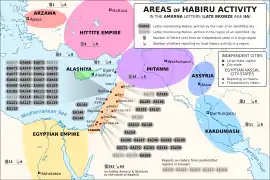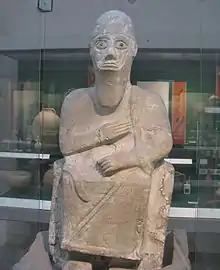Habiru
Habiru (sometimes written as Hapiru, and more accurately as ʿApiru, meaning "dusty, dirty"[1]) is a term used in 2nd-millennium BCE texts throughout the Fertile Crescent for people variously described as rebels, outlaws, raiders, mercenaries, bowmen, servants, slaves, and laborers.[1][2][3][4][5]

Hapiru, Habiru, and Apiru
In the time of Rim-Sin I (1822 BC to 1763 BC), the Sumerians knew a group of Aramaean nomads living in southern Mesopotamia as Habiru.[6] The word Habiru, more properly ʿApiru, occurs in hundreds of 2nd millennium BCE documents covering a 600-year period from the 18th to the 12th centuries BCE and found at sites ranging from Egypt, Canaan and Syria, to Nuzi (near Kirkuk in northern Iraq) and Anatolia (Turkey), frequently used interchangeably with the Sumerian SA.GAZ, a phonetic equivalent to the Akkadian (Mesopotamian) word saggasu ("murderer, destroyer").[7][8]
Not all Habiru were murderers and robbers:[9] in the 18th century a north Syrian king named Irkabtum (c. 1740 BC) "made peace with [the warlord] Shemuba and his Habiru," [10] while the ʿApiru, Idrimi of Alalakh, was the son of a deposed king, and formed a band of ʿApiru to make himself king of Alalakh.[11] What Idrimi shared with the other ʿApiru was membership of an inferior social class of outlaws, mercenaries, and slaves leading a marginal and sometimes lawless existence on the fringes of settled society.[12] ʿApiru had no common ethnic affiliations and no common language, their personal names being most frequently West Semitic, but many East Semitic, Hurrian or Indo-European.[12][13]
In the Tikunani Prism from Anatolia, dating from around 1550 BC, the names of 438 Habiru soldiers are given. The majority of them had Hurrian names, the rest being Semitic.

In the Amarna letters from the 14th century BCE, the petty kings of Canaan describe them sometimes as outlaws, sometimes as mercenaries, sometimes as day-labourers and servants.[3] Usually they are socially marginal, but Rib-Hadda of Byblos calls Abdi-Ashirta of Amurru (modern Lebanon) and his son ʿApiru, with the implication that they have rebelled against their common overlord, the Pharaoh.[3] In "The Conquest of Joppa" (modern Jaffa), an Egyptian work of historical fiction from around 1440 BCE, they appear as brigands, and General Djehuty asks at one point that his horses be taken inside the city lest they be stolen by a passing ʿApir.[14]
Habiru and the biblical Hebrews
The biblical word "Hebrew", like Habiru, denotes a social category, not an ethnic group.[15] Since the discovery of the 2nd millennium BCE inscriptions mentioning the Habiru, there have been many theories linking these to the Hebrews of the Bible.[6]
As pointed out by Moore and Kelle, while the ʿApiru/Habiru may be related to the biblical Hebrews, they also appear to be composed of many different peoples, including nomadic Shasu and Shutu, the biblical Midianites, Kenites, and Amalekites, as well as displaced peasants and pastoralists.[16][17]
Scholars such as Anson Rainey have noted however, that while ʿApiru covered the regions from Nuzi to Anatolia as well as Northern Syria, Canaan and Egypt, they were never confused with Shutu (Sutu) or Shasu (Shosu), Syrian pastoral nomads in the Amarna letters or other texts of the time.[18]
References
Citations
- Rainey 2008, p. 51.
- Coote 2000, p. 549.
- McLaughlin 2012, p. 36.
- Finkelstein & Silberman 2007, p. 44.
- Noll 2001, p. 124.
- Smith, Homer W. (1952). Man and His Gods. New York: Grosset & Dunlap. p. 89.
- Rainey 2008, p. 52.
- Rainey 2005, p. 134-135.
- Youngblood 2005, p. 134-135.
- Hamblin 2006, p. unpaginated.
- Na'aman 2005, p. 112.
- Redmount 2001, p. 98.
- Coote 2000, p. 549-550.
- Mannassa 2013, p. 5,75,107.
- Blenkinsopp 2009, p. 19.
- Moore & Kelle 2011, p. 125.
- Rainey 1995, p. 483.
- Rainey 1995, p. 490.
Bibliography
- Blenkinsopp, Joseph (2009). Judaism, the First Phase: The Place of Ezra and Nehemiah in the Origins of Judaism. Eerdmans. ISBN 9780802864505.CS1 maint: ref=harv (link)
- Collins, John J. (2014). A Short Introduction to the Hebrew Bible. Fortress Press. ISBN 9781451484359.CS1 maint: ref=harv (link)
- Coote, Robert B. (2000). "Hapiru, Apiru". In David Noel, Freedman; Allen C., Myers (eds.). Eerdmans Dictionary of the Bible. Eerdmans. ISBN 9789053565032.CS1 maint: ref=harv (link)
- Finkelstein, Israel; Silberman, Neil Asher (2007). David and Solomon: In Search of the Bible's Sacred Kings and the Roots of the Western Tradition. Simon and Schuster. ISBN 9780743243636.CS1 maint: ref=harv (link)
- Hamblin, William J. (2006). Warfare in the Ancient Near East to 1600 BC. Routledge. ISBN 9781134520626.CS1 maint: ref=harv (link)
- Lemche, Niels Peter (2010). The A to Z of Ancient Israel. Scarecrow Press. ISBN 9781461671725.CS1 maint: ref=harv (link)
- Manassa, Colleen (2013). Imagining the Past: Historical Fiction in New Kingdom Egypt. Oxford University Press. ISBN 9780199982226.CS1 maint: ref=harv (link)
- McKenzie, John L. (1995). The Dictionary Of The Bible. Simon and Schuster. ISBN 9780684819136.CS1 maint: ref=harv (link)
- McLaughlin, John L. (2012). The Ancient Near East. Abingdon Press. ISBN 9781426765506.CS1 maint: ref=harv (link)
- Moore, Megan B.; Kelle, Brad E. (2011). Biblical History and Israel's Past: The Changing Study of the Bible and History. Grand Rapids, Michigan; Cambridge, UK. ISBN 9780802862600.CS1 maint: ref=harv (link)
- Na'aman, Nadav (2005). Canaan in the Second Millennium B.C.E. Eisenbrauns. ISBN 9781575061139.CS1 maint: ref=harv (link)
- Noll, K.L. (2001). Canaan and Israel in Antiquity: An Introduction. A&C Black. ISBN 9781841273181.CS1 maint: ref=harv (link)
- Rainey, Anson F. (2008). "Who Were the Early Israelites?" (PDF). Biblical Archaeology Review. 34:06 (Nov/Dec 2008): 51–55.CS1 maint: ref=harv (link)
- Rainey, Anson F. (1995). "Unruly Elements in Late Bronze Canaanite Society". In Wright, David Pearson; Freedman, David Noel; Hurvitz, Avi (eds.). Pomegranates and Golden Bells. Eisenbrauns. ISBN 9780931464874.CS1 maint: ref=harv (link)
- Redmount, Carol A. (2001). "Bitter Lives". In Michael David, Coogan (ed.). The Oxford History of the Biblical World. Oxford University Press. ISBN 9780195139372.CS1 maint: ref=harv (link)
- Van der Steen, Eveline J. (2004). Tribes and Territories in Transition. Peeters Publishers. ISBN 9789042913851.CS1 maint: ref=harv (link)
- Youngblood, Ronald (2005). "The Amarna Letters and the "Habiru"". In Carnagey, Glenn A.; Schoville, Keith N. (eds.). Beyond the Jordan: Studies in Honor of W. Harold Mare. Wipf and Stock Publishers. ISBN 9781597520690.CS1 maint: ref=harv (link)
